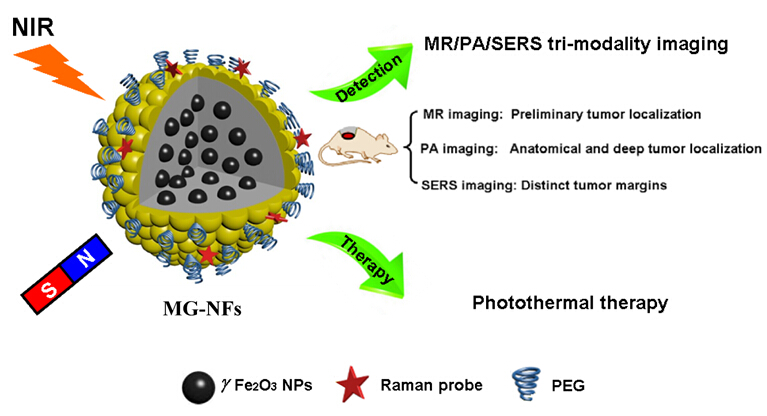Nanotheranostics, the combination of diagnostic and therapeutic functionality in one nanoscale system, has received increasing attention in recent years. Different imaging modalities can be integrated into a single nanoplatform to offer detailed, reliable and complimentary information about the tumor, including its nature, localization, and size. The existing imaging technologies such as near-infrared fluorescence (NIRF), magnetic resonance (MR) imaging, and computed tomography (CT) could not provide the precise information of tumor due to the limitation of spatial resolution, sensitivity, and penetration depth. Therefore, development of new theranostic agents is highly desired to provide precise identification of tumor for better clinical outcome.
Recently, a team led by Prof.ZHANGZhi Jun's from Suzhou Institute of Nano-Tech & Nano-Bionics (SINANO), Chinese Academy of Sciences, in collaboration with Prof. Huabing Chen at Soochow University and Prof. Bin Ren from Xiamen University, has developed γFe2O3@Au core/shell magnetic gold nanoflowers (MG-NFs)-based theranostic nanoplatform with MRI/PA/SERS multimodal imaging and photothermal therapeutical functionalities. From the in vitro and in vivo experiments with the MG-NFs, the researchers obtained complementary information about the tumor contour and localization by MR imaging, the anatomical and deep tumor localization from PA imaging, and the fine tumor margin identification using SERS imaging, all of which are very useful for tumor detection and surgery guidance. Moreover, MG-NFs exhibit excellent photothermal effect that leads to efficient tumor ablation upon photo irradiation. This work was recently published in Advanced Materials (Adv. Mater., 2015, published online, DOI: 10.1002/adma.201501942).
This work was supported by National Basic Research Program, National Natural Science Foundation of China, and the CAS/SAFEA International Innovation Teams program.

Scheme 1. The illustration of γFe2O3@Au core/shell magnetic gold nanoflowers (MG-NFs) for multimodal imaging and photothermal therapy of tumor.(Image by ZHANGZhi Jun's Group)

